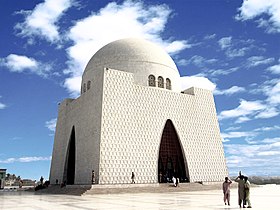信德省
| 信德省 سندھ | |||
|---|---|---|---|
| 省 | |||
| |||
 在巴基斯坦的位置 | |||
| 坐标:24°52′N 67°03′E / 24.87°N 67.05°E | |||
| 首府 | 卡拉奇 | ||
| 辖县 | 29 | ||
| 所辖乡 | 119 | ||
| 成立 | 1970年7月1日 | ||
| 政府 | |||
| • 省长 | Imran Ismail | ||
| • 首席部长 | 赛义德·穆拉德·阿里·沙 | ||
| 面积 | |||
| • 总计 | 140,914 平方公里(54,407 平方英里) | ||
| 人口(2017年)[1] | |||
| • 总计 | 47,886,051人 | ||
| • 密度 | 340人/平方公里(900人/平方英里) | ||
| 网站 | http://www.sindh.gov.pk | ||
信德省(Sindh;信德语:سنڌ;乌尔都语:سندھ;罗马化拼写曾作Sind)是巴基斯坦的四个省之一。信德省位于该国东南部地区,是巴基斯坦总面积第三大省,人口仅次于旁遮普省的第二大省。它分别与北部的巴基斯坦俾路支省和旁遮普省以及东部的印度古吉拉特邦和拉贾斯坦邦接壤;它的南面以阿拉伯海为界。信德省的景观主要由印度河两侧的冲积平原、该省东部与印度接壤的塔尔沙漠和该省西部的基尔塔尔山脉组成。
信德省的经济是巴基斯坦仅次于旁遮普省的第二大经济体;其省会卡拉奇是该国人口最多的城市,也是其主要金融中心。信德省是巴基斯坦大部分工业机构的所在地,并拥有该国两个最繁忙的商业海港:卡西姆港和卡拉奇港。信德省的其余地区以农业为基础,为该国其他地区生产水果、日用品和蔬菜[2][3][4]。
信德省有时被称为Bab-ul Islam(译作“伊斯兰之门”),因它是印度次大陆最早受伊斯兰政权统治的地区之一。现代省份的部分地区在早期穆斯林征服期间受到拉什顿军队(英语:Rashidun army,即正统哈里发政权当时的核心武装力量)的间歇性袭击,但该地区直到712年由穆罕默德·伊本·卡西姆领导的倭马亚哈里发统治下发生阿拉伯入侵信德后,才落入穆斯林政权的统治[5][6]。信德族是该省最大的群体;信德省也是绝大多数穆哈吉尔人(乌尔都语:مہاجر,拼写作Mahajir或Mahajir、Mohajir等,字面意思是“移民”)的居住地,为一个多民族的印度穆斯林群体,他们在1947年印巴分治后迁移到该地区。该省以其受苏菲派强烈影响的独特文化闻名,苏菲派是当地印度教徒和穆斯林身份认同的共同重要标志[7]。
信德省以其在印度河流域文明时期的青铜时代的历史而闻名,并且是联合国教科文组织指定的两个世界遗产地的所在地:马克利墓地(英语:Makli Necropolis,世界当今最大的大墓地之一,约有50至100万座[8],建立于约400年期间的坟墓[9],以数座献给皇室、苏菲派重要人物、学者的纪念物为特色,被认定是信德地区文明14至18世纪发展的重要遗迹[10])和摩亨佐达罗[11]。
该省的(官方)象征动物为信德羱羊(Sindh ibex)[12],象征鸟类为黑鹑[12],象征树种为印度苦楝树[13]。以该地区名称命名之物种有信德羱羊及信德麻雀等。
词源
公元前 325 年在亚历山大大帝的指挥下征服信德的希腊人将印度河(英语:Indus River)称为 Indós,现代之Indus称呼由此衍生。 古代伊朗人把印度河以东的一切都称为hind(现代罗马化拼写形式)。[14][15] Sindh 一词是梵语 Sindhu 的波斯语派生词,意思是“河流”—指印度河。[16]
Franklin Southworth 认为 Sindhu 这个名字又来源于 Cintu,这是一个德拉威语中枣椰树的意思,一种在当地常见的树。[17][18]
行政区划
参考文献
- ^ DISTRICT WISE CENSUS RESULTS CENSUS 2017 (PDF). www.pbscensus.gov.pk. [2018-05-14]. (原始内容 (PDF)存档于2017-08-29).
- ^ Staff reporter. Sindh must exploit potential for fruit production. The Nation, 2014. The Nation. 9 March 2014 [29 May 2015]. (原始内容存档于2017-10-02).
- ^ Markhand, Ghulam Sarwar; Saud, Adila A. Dates in Sindh. Proceedings of the International Dates Seminar (SALU Press). [29 May 2015]. (原始内容存档于2022-03-01).
- ^ Editorial. How to grow Bananas. Dawn News, 2007. Dawn News. 3 September 2007 [29 May 2015]. (原始内容存档于2022-03-10).
- ^ Quddus, Syed Abdul. Sindh, the Land of Indus Civilisation. Royal Book Company. 1992 [2022-02-10]. ISBN 978-969-407-131-2. (原始内容存档于2022-03-01) (英语).
- ^ JPRS Report: Near East & South Asia. Foreign Broadcast Information Service. 1992 [2022-02-10]. (原始内容存档于2022-03-01) (英语).
- ^ Judy Wakabayashi; Rita Kothari. Decentering Translation Studies: India and Beyond. John Benjamins Publishing. 2009: 132– [2022-02-10]. ISBN 978-90-272-2430-9. (原始内容存档于2022-03-01).
- ^ Makli Hill. ArchNet. Aga Khan Trust for Culture and the Massachusetts Institute of Technology (MIT). [17 July 2017]. (原始内容存档于2019-04-10).
- ^ Historical Monuments at Makli, Thatta. UNESCO. [17 July 2017]. (原始内容存档于2012-08-08).
- ^ Historical Monuments at Makli, Thatta (页面存档备份,存于互联网档案馆) UNESCO World Heritage Centre. Retrieved 10 February 2011
- ^ Properties inscribed on the World Heritage List (Pakistan). UNESCO. UNESCO. [14 July 2016]. (原始内容存档于2016-07-04).
- ^ 12.0 12.1 Hussain. ‘Our Sindhi symbols – ibex, black partridge’ | Pakistan Today. [2022-02-10]. (原始内容存档于2022-03-01) (英国英语).
- ^ Govt declares Neem `provincial tree`. DAWN.COM. 2010-04-15 [2022-02-10] (英语).
- ^ Choudhary Rahmat Ali. Now or Never. Are we to live or perish forever?. 28 January 1933 [2022-02-10]. (原始内容存档于2008-06-30).
- ^ S. M. Ikram. Indian Muslims and partition of India. Atlantic Publishers & Dist. 1 January 1995: 177– [23 December 2011]. ISBN 978-81-7156-374-6. (原始内容存档于2022-03-01).
- ^ Phiroze Vasunia 2013,第6页.
- ^ Southworth, Franklin. The Reconstruction of Prehistoric South Asian Language Contact (页面存档备份,存于互联网档案馆) (1990) p. 228
- ^ Burrow, T. Dravidian Etymology Dictionary (页面存档备份,存于互联网档案馆) p. 227
- ^ Sindh, not Sind. The Express Tribune (Web Desk). 12 February 2013 [16 October 2015]. (原始内容存档于2022-03-01).
延伸阅读
[在维基数据编辑]
| ||||||||||||||||||||||
| |||||||||||||||||||
Text is available under the CC BY-SA 4.0 license; additional terms may apply.
Images, videos and audio are available under their respective licenses.








